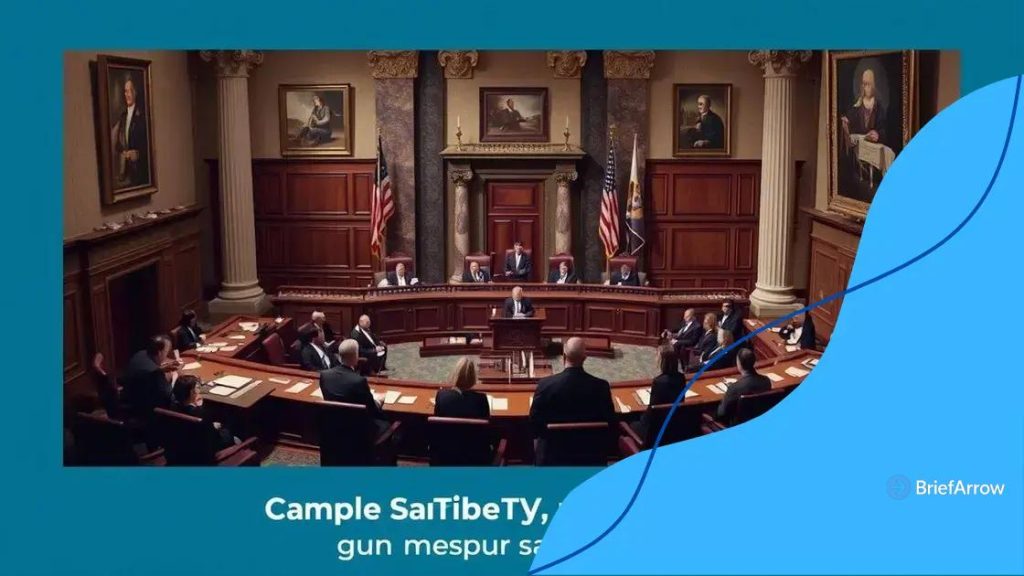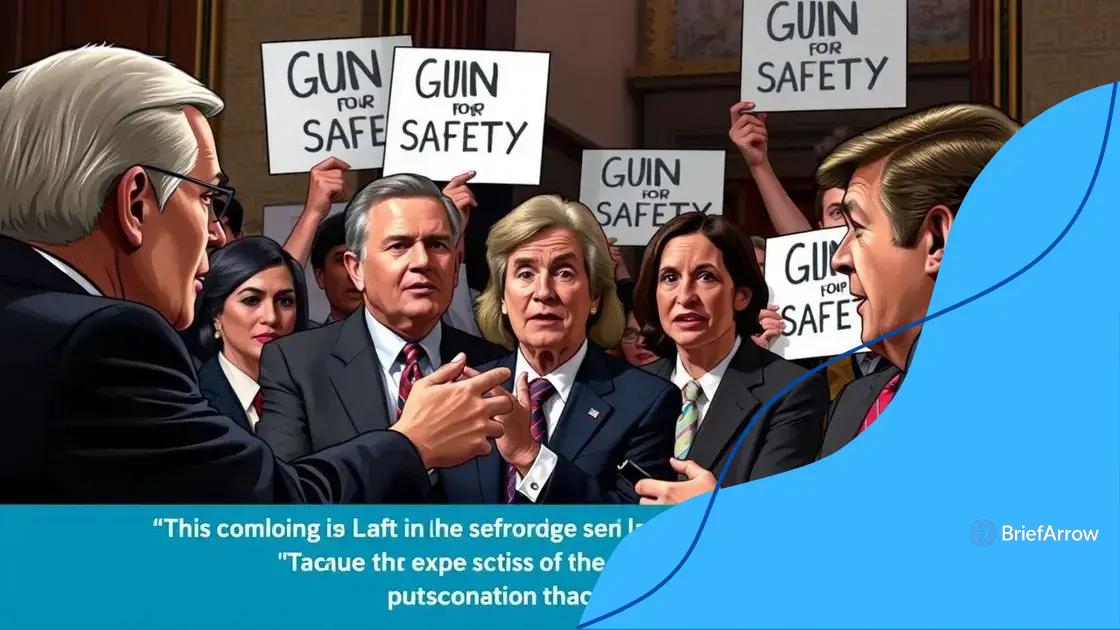House committee advances gun safety legislation for all

Anúncios
The proposed gun safety legislation aims to enhance public safety through stricter background checks and red flag laws, while facing challenges such as bipartisan divides and lobbying from gun rights organizations.
House committee advances gun safety legislation aimed at improving public safety is stirring significant conversations across the country. Have you wondered how these changes might affect everyday life? Let’s dive deeper into the details.
Anúncios
Overview of the proposed gun safety legislation
The proposed gun safety legislation is a significant step towards enhancing public safety. This legislation aims to address pressing issues related to gun violence while ensuring that the rights of responsible gun owners are respected.
Key Features of the Legislation
One important aspect of the proposed legislation is the focus on background checks. This initiative seeks to close loopholes that currently allow some individuals to acquire firearms without a comprehensive check. Additionally, the legislation emphasizes strict measures on assault weapons and high-capacity magazines.
Public and Political Reactions
Reactions to the proposed gun safety measures have been mixed. Supporters argue that these changes are essential for protecting communities, while opponents often express concerns about potential infringements on their rights. This debate highlights the complexities involved in crafting legislation that addresses both safety and freedom.
Anúncios
- Enhanced background checks to promote responsible ownership.
- Restrictions on assault weapons to reduce potential violence.
- Collaboration with law enforcement to implement safety measures.
- Community education initiatives about gun safety.
Furthermore, advocates for gun safety believe that this legislation could pave the way for more comprehensive reforms in the future. The ongoing discussions in Congress indicate a growing consensus on the urgency of this issue.
As the proposed gun safety legislation moves forward, it is crucial for stakeholders to engage in constructive dialogue. This will help ensure that the resulting laws effectively balance public safety with the rights of individuals. The outcome of this legislative effort will undoubtedly shape the landscape of gun ownership and safety for years to come.
Key provisions and their implications
The key provisions of the proposed gun safety legislation are designed to create a safer environment for all citizens. Each provision aims to tackle different aspects of gun violence and ownership responsibility.
Background Checks
One major provision involves mandatory background checks for all gun sales, including those made at gun shows and online. This change is essential to ensure that individuals with criminal backgrounds or serious mental health issues do not obtain firearms.
Red Flag Laws
Another critical component of the legislation is the introduction of red flag laws. These laws allow families and law enforcement to petition courts to temporarily remove firearms from individuals deemed a danger to themselves or others. This proactive measure could prevent potential tragedies before they occur.
- Enhances public safety by monitoring gun ownership
- Promotes responsible gun ownership among citizens
- Encourages community support and intervention
- Minimizes the risk of impulsive acts of violence
Moreover, the legislation proposes stricter regulations on the sale of assault weapons and high-capacity magazines. These measures are aimed at reducing the lethality of firearms in public spaces. Limiting access to such weapons can help diminish the scope of mass shootings.
As these key provisions unfold, their implications will ripple through communities, prompting discussions about the balance between rights and safety. Families, activists, and lawmakers are closely watching how these changes will influence behavior and safety in their neighborhoods.
Reactions from lawmakers and advocacy groups

The reactions from lawmakers and advocacy groups regarding the proposed gun safety legislation reveal a landscape of diverse opinions and intense discussions. Many lawmakers are vocal about their support, emphasizing the need for change to combat rising gun violence.
Supportive Voices
Several politicians have praised the legislation as a vital step toward enhancing public safety. They argue that tighter regulations on gun ownership can lead to fewer incidents of violence and create safer communities for everyone. These lawmakers often cite tragic events that highlight the need for reform.
Opposition Concerns
On the other hand, some lawmakers express concerns that this legislation may infringe on the rights of responsible gun owners. They argue that implementing stricter laws could penalize law-abiding citizens rather than target those who misuse firearms. This divide in perspectives illustrates the complexity of balancing rights with safety.
- Supporters emphasize the importance of public safety.
- Critics warn against potential overreach in gun regulations.
- Advocacy groups are pushing for community engagement.
- Lawmakers are divided along party lines regarding these measures.
Advocacy groups, including those dedicated to gun safety, are actively involved in promoting the legislation. They host community events and mobilize citizens to voice their opinions. These organizations believe that public support can influence lawmakers and lead to stronger, more effective laws.
Conversely, groups opposing the legislation argue that the focus should be on mental health resources and improving enforcement of existing laws rather than adding new restrictions. This ongoing debate showcases the challenge of achieving consensus on how best to address gun violence while respecting individual rights.
Potential challenges in the legislative process
The legislative process surrounding gun safety legislation is often complicated and faces numerous challenges. As lawmakers discuss and debate the proposed measures, they encounter a variety of obstacles that could affect the bill’s success.
Bipartisan Divides
One of the most significant challenges is the divide between political parties. Lawmakers are often split, with differing opinions on how best to address gun issues. This division can lead to lengthy debates and hinder the ability to reach a consensus. Some lawmakers advocate for strict regulations, while others champion individual gun rights.
Public Opinion
Public sentiment also plays a crucial role in the legislative process. Advocacy groups actively campaign for or against the proposed legislation, influencing how lawmakers respond. If the general public feels strongly in favor of tighter gun controls, lawmakers may feel pressure to act. Conversely, backlash from constituents who oppose such measures could deter them from supporting the bill.
- Balancing party interests can complicate negotiations.
- Public advocacy may sway lawmakers’ decisions.
- Media coverage can shape perceptions about the legislation.
- Lobbying efforts from gun rights organizations present additional hurdles.
Moreover, lobbying from powerful gun rights organizations often complicates the conversation. These groups frequently exert significant influence on lawmakers, pushing against new regulations and advocating for individual rights. This pressure can slow down the legislative process and impact proposed changes before they are formally introduced.
As lawmakers work to navigate these challenges, they must find common ground to effectively address public safety concerns. Cooperation among stakeholders, including lawmakers and advocates, is essential to advance meaningful legislation that can gain support across the political spectrum.
Impact on communities and future legislation
The impact of gun safety legislation extends far beyond the halls of Congress; it reaches into the fabric of our communities. As these laws are discussed and implemented, various communities experience the effects in different ways.
Community Safety
One of the primary effects of this legislation is an increase in community safety. Stricter background checks and red flag laws aim to keep firearms out of the hands of individuals who may pose a threat. Communities may feel a sense of relief knowing that measures are in place to prevent potential violence.
Public Awareness
Moreover, the focus on gun safety also raises public awareness about the importance of responsible gun ownership. As discussions evolve, communities are encouraged to engage in conversations about how to promote safety while respecting individual rights. Education plays a crucial role in helping citizens understand the implications of these laws.
- Increased dialogue about gun safety in schools and local events.
- Community support initiatives to help enforce new laws.
- Empowerment of local organizations to promote awareness.
- Reduction in the stigma associated with discussing gun violence and safety.
As communities adapt to these new regulations, the potential for further legislation also arises. The effects of current laws may lead to more extensive reforms in the future, shaping how society approaches gun ownership and safety.
Community leaders, activists, and residents are likely to advocate for continued changes based on the results of these initial laws. If communities see positive outcomes—such as reduced gun violence—the push for more comprehensive reforms will likely intensify.
FAQ – Frequently Asked Questions about Gun Safety Legislation
What are the main goals of the proposed gun safety legislation?
The main goals are to enhance public safety by implementing stricter background checks and promoting responsible gun ownership.
How does the legislation affect community safety?
The legislation aims to reduce gun violence, potentially leading to safer environments in communities across the country.
What challenges does the legislation face in Congress?
The legislation faces bipartisan divides, lobbying efforts from gun rights organizations, and varying public opinions that can complicate the process.
How can community members get involved with this issue?
Community members can engage by attending public meetings, advocating for gun safety, and participating in local discussions about the proposed laws.